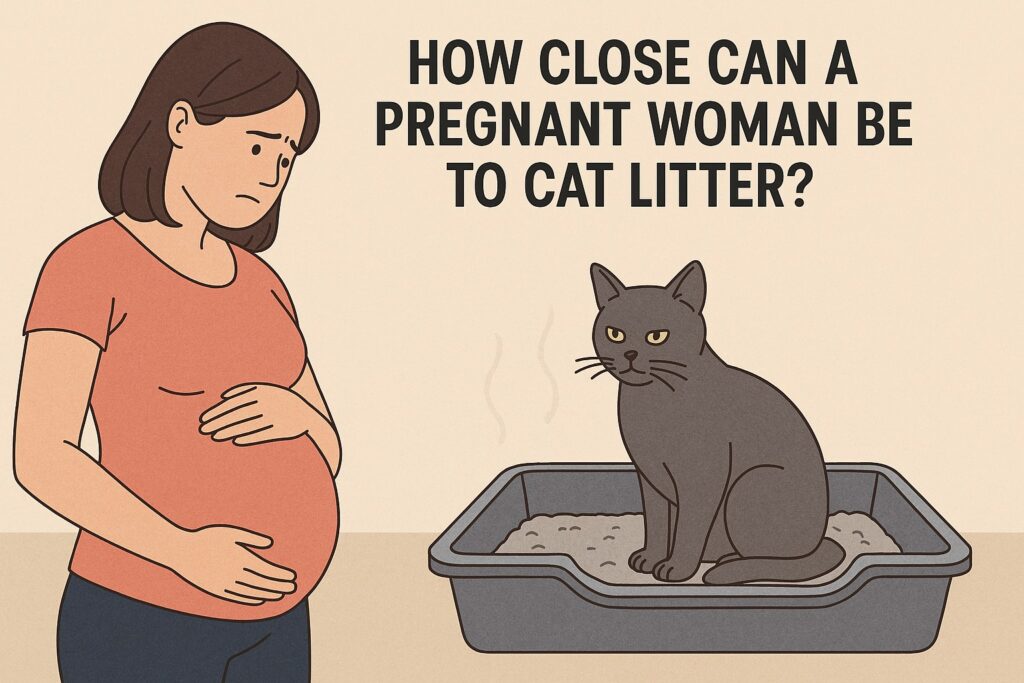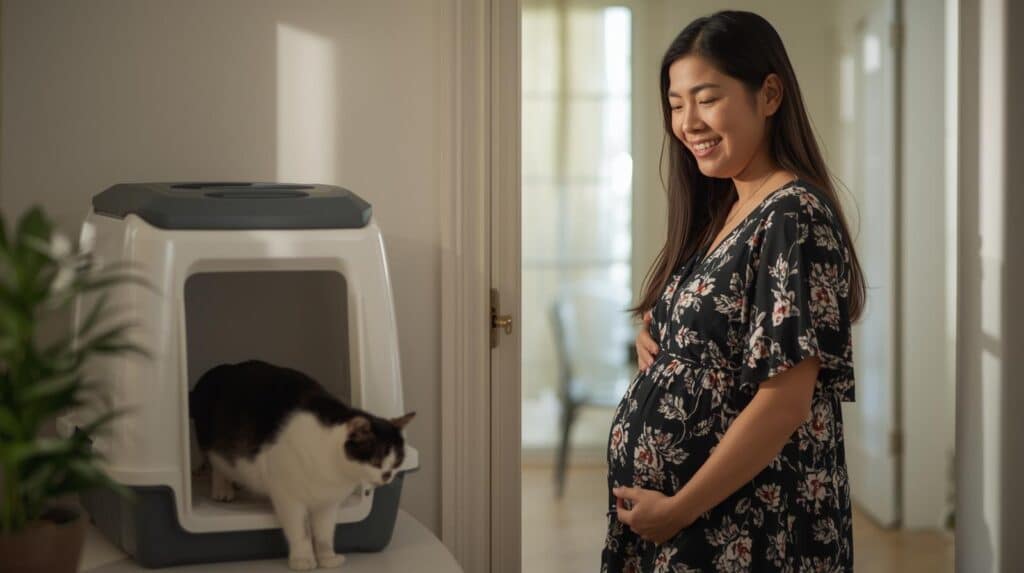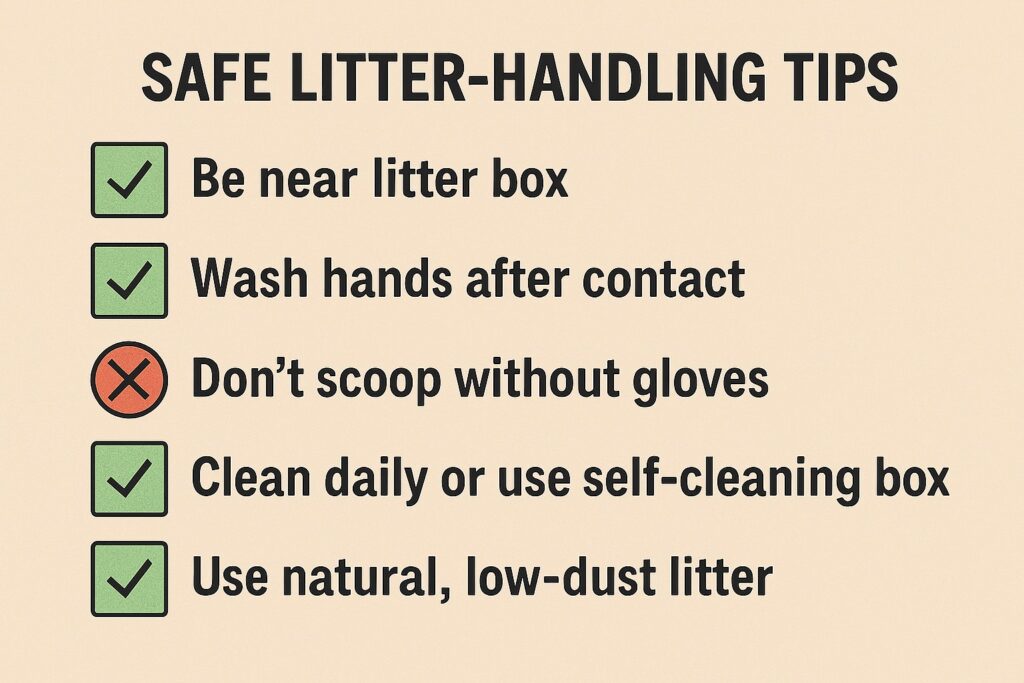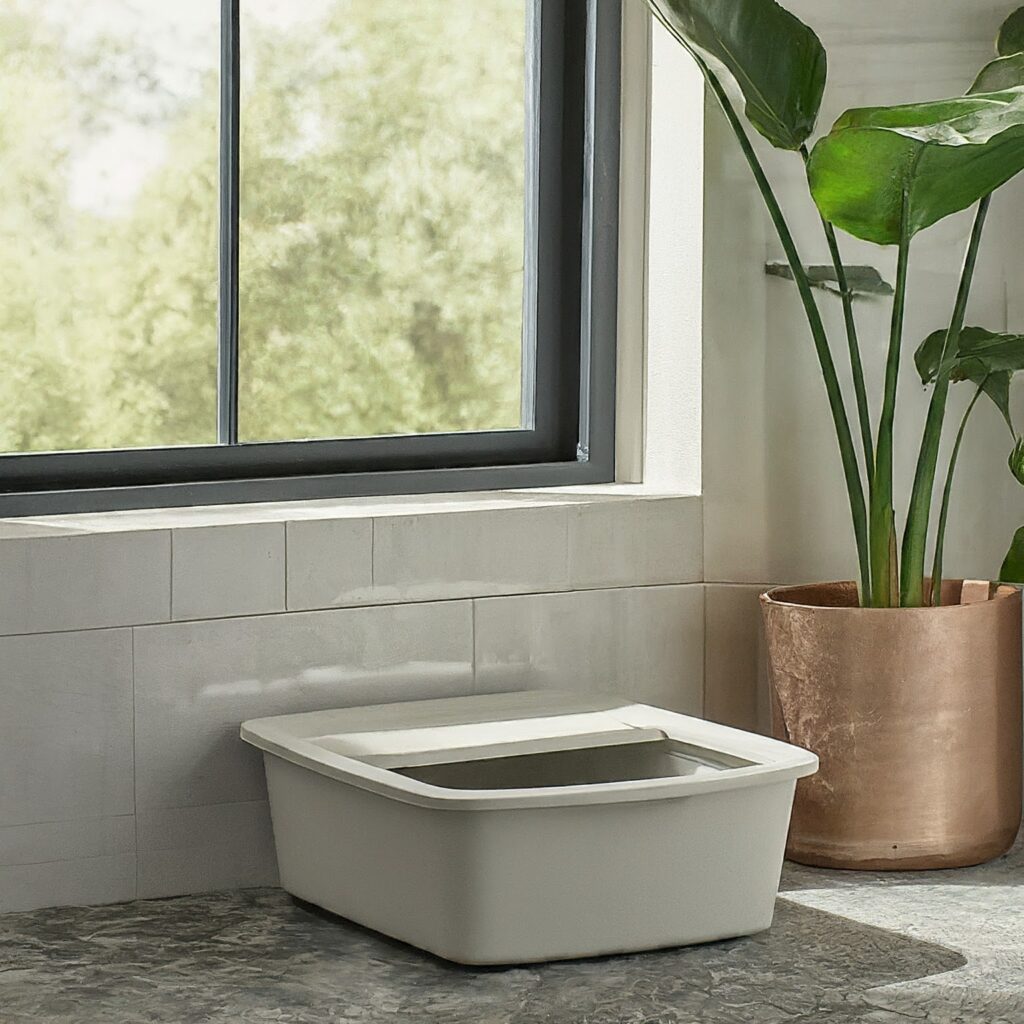
Pregnancy comes with a lot of do’s and don’ts, and if you’re a cat parent, one of the first worries that often comes up is: “How Close Can a Pregnant Woman Be to Cat Litter?” You’re not alone—many expectant moms feel anxious about whether cat litter could harm their baby.
The truth is, the risk isn’t the cat itself but a parasite called toxoplasmosis, which can sometimes be found in cat feces. While the thought sounds scary, the good news is that with the right precautions, you can keep both your baby and your cat safe.
Let’s break this down in simple terms so you know exactly how close you can be to cat litter during pregnancy—and what steps you can take to stay worry-free.
Table of Contents
How Close Can a Pregnant Woman Be to Cat Litter?
A pregnant woman can safely be in the same room as a cat litter box as long as she doesn’t touch or clean the litter. The health risk comes from direct contact with cat feces that may contain the parasite Toxoplasma gondii, not from simply being near the litter box.
- Safe: Sitting in the same room, walking past the litter box, or being close to it without touching.
- Caution: Cleaning or scooping the litter, especially if it has been sitting for more than 24 hours.
- Best practice: Have someone else clean the box during pregnancy, or wear gloves and wash your hands thoroughly if you must do it yourself.
In short, being near cat litter is safe, but handling dirty litter is what poses a risk during pregnancy.
Why Cat Litter Is a Concern During Pregnancy
The main reason doctors and health experts caution pregnant women about cat litter is a parasite called Toxoplasma gondii, which can cause an infection known as toxoplasmosis. According to the Centers for Disease Control and Prevention (CDC) and the American College of Obstetricians and Gynecologists (ACOG), toxoplasmosis is usually mild or symptom-free in healthy adults, but it can be dangerous for an unborn baby. In rare cases, it may lead to complications like vision problems, developmental delays, or even miscarriage.
How Cats Can Transmit Toxoplasmosis
- Cats can pick up the parasite if they hunt and eat infected rodents, birds, or raw meat.
- Once infected, the parasite can be passed through their feces into the litter box.
- Indoor-only cats who eat only commercial cat food are at very low risk of carrying toxoplasmosis. The higher concern is for outdoor cats or cats that eat raw food.
What the Numbers Really Say
It’s important to keep the risk in perspective. Studies show that not all cats carry this parasite—in fact, most indoor cats never do. Even if a cat is infected, they typically only shed the parasite in their feces for a short period of time (1–3 weeks) in their entire lifetime. That means the overall chance of a pregnant woman catching toxoplasmosis from her cat’s litter box is quite low.
The key risk comes from directly handling or inhaling particles from contaminated litter, which is why doctors recommend extra caution during pregnancy.
Is It Safe to Be Near Cat Litter While Pregnant?
Yes — it is generally safe to be near a cat litter box while pregnant as long as you don’t touch or clean the litter. The risk comes only from direct contact with cat feces that may contain the parasite Toxoplasma gondii.

- Standing near a litter box → Safe.
- Being in the same room → Safe, as long as you don’t handle the litter.
- Actual risk → Comes from scooping or touching dirty litter.
- Myth-busting → You cannot get toxoplasmosis just from the smell of cat litter or being in the same airspace.
- Quick Answer: Being around a cat litter box is safe during pregnancy; only cleaning or touching dirty litter poses a risk.
Can Pregnant Women Clean Cat Litter?
Pregnant women should avoid cleaning cat litter whenever possible because of the small risk of toxoplasmosis. The safest option is to have someone else take care of the litter box during pregnancy.
If you must clean it yourself:
- Wear disposable gloves to avoid direct contact.
- Use a mask to reduce exposure to litter dust.
- Wash your hands thoroughly with soap and warm water afterward.
- Clean the box daily — the parasite in cat feces needs 1–5 days to become infectious, so frequent cleaning lowers risk.
- Consider a self-cleaning litter box or disposable litter trays for extra safety and convenience.
Answer: Pregnant women can clean cat litter if necessary, but it’s best to delegate the task and always use proper protection.
Hidden Concerns Pregnant Women Often Worry About
Pregnancy brings new worries, and cat parents often have extra questions that don’t always show up in search results but still matter. Here are some common hidden concerns:
Breathing in Cat Litter Dust – Is It Harmful?
Normal litter dust is more of an irritant than a risk of infection. While it won’t give you toxoplasmosis, breathing in too much dust can cause throat or lung irritation. To be safe, choose a low-dust or paper-based litter and keep the box in a well-ventilated space.
Clumping Litter Chemicals & Fragrances – Safe or Risky?
Most clumping agents (like bentonite clay) aren’t dangerous unless ingested. However, strongly scented litters can trigger nausea or headaches during pregnancy. Unscented, natural litters (like paper, wood, or corn-based) are usually the safest choice.
Touching Cat Fur or Paws – Can Cats Carry Feces Around?
Cats are generally clean animals, but microscopic particles from the litter box can stick to fur or paws. This risk is very low, but if your cat walks on the bed or couch, you can wipe their paws regularly and vacuum more often during pregnancy.
What If I Already Cleaned the Litter Before Knowing I Was Pregnant?
Don’t panic — most exposures don’t lead to infection. If you’re worried, ask your doctor about a toxoplasmosis blood test to check for immunity or recent infection.
Is It Safe If My Toddler Touches the Litter Box While I’m Pregnant?
Yes — but it’s still unhygienic. Your toddler can’t “give” you toxoplasmosis by touching the litter box, but it increases household exposure risk. The best solution is to keep the litter area out of reach of children and wash their hands right away if they get too curious.
Does Pregnancy Immunity Matter If I’ve Had Cats Before?
Yes. If you’ve already been exposed to toxoplasmosis earlier in life, your body may have developed immunity, which protects your baby during pregnancy. Your doctor can confirm this with a simple blood test.
Quick Takeaway: Most hidden risks (dust, fur, fragrances, toddlers) are manageable with good hygiene and safe litter choices. The main concern is still direct contact with dirty litter, not casual everyday exposure.
Alternatives & Safety Hacks for Pregnant Cat Owners

If you’re expecting and want to enjoy life with your cat without worry, there are plenty of simple changes that make litter care safer during pregnancy.
Self-Cleaning Litter Boxes
Automatic litter boxes reduce the frequency of scooping, thereby limiting your exposure to cat feces. They’re one of the easiest ways to lower your risk (and a time-saver once the baby arrives).
The best self-cleaning that you can use during pregnancy and afterwards are Litter Robot 4 (Best Overall) and PetSafe Scoop Free Litter automatic box (Best Value), and Teweoa Self Cleaning Cat Litter Box (Budget-Friendly).
These litter boxes make your life hassle-free, with no daily scooping, disposing, or cleaning. If you don’t have one, consider buying one and see how this will turn your life.
If you are low on budget, you can also consider buying Semi Automatic litter box; these also save you from direct touch or scoop litter, you just have to pull the lever and that’s it.
Paper or Natural Litters
Switching to low-dust, natural litters (like paper pellets, wood, walnut, or corn-based) helps minimize airborne particles. These options are gentler for both pregnant women and cats with sensitive paws.
Here are the best natural cat litters you can consider during pregnancy: Naturally Fresh Walnut Shell litter (Best Overall) and ARM & HAMMER Naturals Corn Fibers litter (Best For Clumping and multicat)
If you want to make paper litter at home, check out this guide: How to Make Zero Waste Shredded Newspaper Cat Litter: A Step-by-Step Guide
Protective Gear: Gloves & Masks
If you must handle the litter box, use disposable gloves and a simple face mask to avoid contact with waste and reduce inhalation of dust. Always wash your hands thoroughly afterward.
Keep the Litter Box in a Separate Area
Place the box in a well-ventilated, low-traffic area of your home. Keeping it away from bedrooms and nurseries adds peace of mind.
Cat Hygiene Tips
- Wipe your cat’s paws with a damp cloth if they step in litter.
- Keep nails trimmed to avoid litter tracking.
- Regular grooming reduces the chance of stray particles ending up on furniture.
When Should You See a Doctor?
Most cat owners go through pregnancy without any issues, but it’s important to know when to get medical advice.
- If you’ve been exposed to cat feces and are worried, for example, if you cleaned the litter without gloves or discovered your cat may have been outdoors hunting.
- If you notice symptoms of toxoplasmosis, these can include mild flu-like signs such as fever, fatigue, muscle aches, or swollen lymph nodes. Many people don’t develop symptoms, which is why testing can be useful.
- If you want to check your immunity, A simple blood test can show whether you’ve already been exposed to Toxoplasma gondii in the past. If you’re immune, your baby is generally protected during pregnancy.
Quick Takeaway: If you’re unsure about your risk, ask your doctor about a blood test. It’s the easiest way to ease your mind and protect your baby.
Key Takeaways
- Being near cat litter is safe during pregnancy — the risk comes only from direct contact with cat feces that may contain Toxoplasma gondii.
- With a few precautions, such as delegating litter duty or using gloves and masks, you can continue living safely with your cat throughout pregnancy.
- Practical tips include cleaning the box daily, switching to low-dust or natural litters, and considering a self-cleaning litter box to minimize contact.
Bottom line: You don’t need to give up your cat while pregnant. With safe habits and a little extra care, you can protect your baby and keep your bond with your pet strong.
Pregnancy doesn’t mean you have to avoid your cat — just their litter box. By following these simple precautions, you can keep both your baby and your furry friend safe and comfortable.
For more medical guidance, check out:
FAQs: How Close Can a Pregnant Woman Be to Cat Litter?
Can I be in the same room as cat litter while pregnant?
Yes. It’s safe to be in the same room with a litter box as long as you don’t touch or clean it. The risk only comes from handling cat feces directly.
Can I cuddle with my cat while pregnant?
Absolutely. Petting or cuddling your cat is safe. Just wash your hands after playtime, especially before eating, to practice good hygiene.
Can I get toxoplasmosis from cat fur?
Very unlikely. Toxoplasmosis is spread through cat feces, not through normal fur contact. At most, particles could transfer if a cat stepped in litter, but regular grooming and paw-wiping reduce this risk even further.
Can I change litter during the first trimester?
It’s best to avoid cleaning the litter box throughout pregnancy, but especially in the first trimester when the baby is developing. If you must do it, wear gloves, use a mask, and wash your hands afterward.
How long can I stay in a room with cat litter while pregnant?
There’s no time limit. You can stay in the same room as long as you’re not scooping or touching the litter. The parasite only spreads through contact with contaminated feces.
Is cat litter dust harmful to pregnant women?
Cat litter dust does not carry toxoplasmosis, but it can irritate the lungs and trigger nausea. Choosing low-dust or paper-based litters is safer during pregnancy.
What if I already touched cat litter before knowing I was pregnant?
Don’t panic. Most exposures do not cause infection. If you’re worried, ask your doctor for a toxoplasmosis blood test to check immunity or recent exposure.







